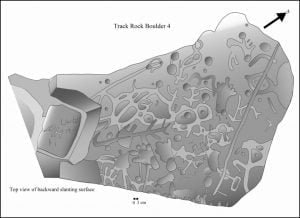On one of the six main boulders of the Track Rock petroglyphs near Brasstown Bald Mountain, GA and across Track Rock Gap Road from the Track Rock Terrace Complex, a Jewish girl carved her first name, Liube, and the date, 1715. The drawing of the petroglyphs was prepared by South African archaeologist, Johannes Loubser, as part of a contract with the U.S. Forest Service. The six drawings are published on a public USFS web site. 1
Liube is a Jewish female name that is mostly used in Slavic countries. 2It means “beloved” and in the past was a name that rabbis liked to give one of their daughters. Why a Jewish woman named Liube was on a trail near Brasstown Bald Mountain in 1715, one can only speculate. It was a dangerous time for any European to be in the wilderness.

The inscription was made 260 miles as a crow flies from the nearest English settlement . . . in the midst of the one of the bloodiest wars between Native Americans and European settlers ever fought. At the time, the Southeastern tribes were killing all the South Carolina traders in their midst, but usually not harming traders from Virginia. Perhaps Liube’s father was killed and she was taken captive. “Liube 1715” is highly significant and probably could be made the basis of a blockbuster movie, yet…
The report prepared for the USFS made no mention of the “Liube 1715” inscription. 3 The Track Rock petroglyphs were described as probably being graffiti made by bored Cherokee hunters. The half square mile stone terrace complex to the east was described as being probably built by the Cherokees. Track Rock was in Creek territory until 1785. The Cherokees have absolutely no tradition of building stone structures or mounds. The Track Rock petroglyphs also include four Maya glyphs that can be translated, several animals, plus many Muskogean ritualistic symbols found at Etowah Mounds in northwest Georgia and Ocmulgee Mounds in Macon, Georgia. Both are considered mother towns of the Creek Indians. 4
See Further:
- The Track Rock Terrace Complex
- Interpretation of the Track Rock Gap Petroglyphs
- Site Tour of the Track Rock Gap Archaeological Zone
- Track Rock Gap Archaeological Survey
- Discerning Facts and Myths About Track Rock Gap
Citations:
- Track Rock Petroglyph Web Site[↩]
- Stone inscription proves early presence of Jewish settlers in the Appalachians[↩]
- Loubser, Johannes, An Archaeological and Ethnohistorical Appraisal of a Piled Stone Feature Complex In the Mountains of North Georgia, Report prepared for U.S. Forest Service by Stratum Unlimited, LLC, 2000. [↩]
- Thornton, Richard, Itsapa, the Itza Mayas in North America, Raleigh: Lulu Publishers, Inc. 2011, p. 12.[↩]
